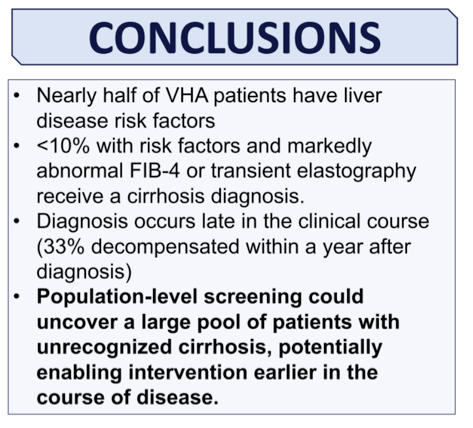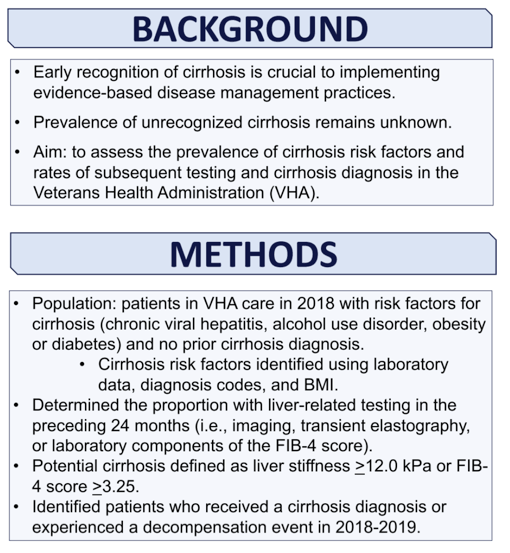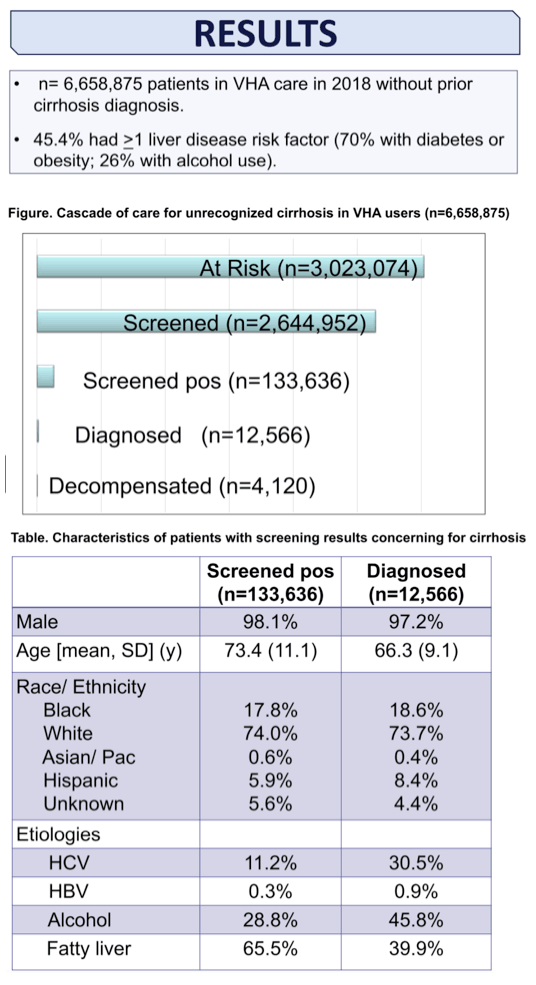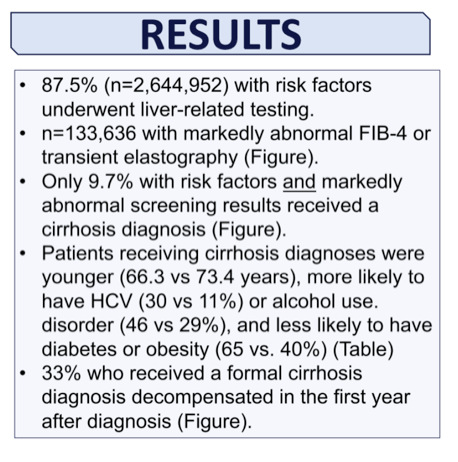 |
 |
 |
| |
OPPORTUNITIES FOR EARLY DIAGNOSIS OF UNRECOGNIZED CIRRHOSIS IN THE DEPARTMENT OF VETERANS AFFAIRS
|
| |
| |
AASLD 2020 Nov 11-16
Lauren A. Beste1,2,3, Tzu-Hao Lee4,5,6, Elliott Lowy1, Christine M. Hunt6, Shari S. Rogal7, Jasmohan S. Bajaj8,9, Ina Gylys- Colwell10, Maggie Chartier11,12 and Timothy R. Morgan13,14, (1)VA Puget Sound Health Care System, (2)Primary Care, Veterans Affairs Puget Sound Healthcare System, (3) University of Washington, (4)GI, Durham VA, (5)Durham VA Health Care System, (6)Division of Gastroenterology, Duke University Medical Center, (7)Departments of Medicine and Surgery, University of Pittsburgh, (8)Virginia Commonwealth University, (9)Mcguire VAMC, (10)Health Services Research & Development, VA Puget Sound Health Care System, (11) Department of Veterans Affairs, (12)HIV, Hepatitis and Related Conditions Programs, Department of Veterans Affairs, (13)Chief of Hepatology, VA Long Beach Healthcare System., (14)VA Long Beach Healthcare System
Background: Early recognition of cirrhosis is crucial to implementing evidence-based disease management practices. The prevalence of unrecognized cirrhosis remains unknown. We aimed to assess the prevalence of liver disease risk factors and rates of subsequent testing and cirrhosis diagnosis in the Veterans Health Administration (VHA) system.
Methods: We used laboratory data, diagnosis codes, and body mass index data to identify patients in VHA care in 2018 with risk factors for cirrhosis, including chronic viral hepatitis, alcohol use disorder, obesity or diabetes. Among patients without a prior cirrhosis diagnosis, we determined the proportion with liver-related testing in the preceding 24 months (i .e ., imaging, transient elastography, or laboratory components of the FIB-4 score). Next, we identified potential cirrhosis, defined as liver stiffness >12.0 kPa or FIB-4 >3 .25. Finally, we identified patients who received a cirrhosis diagnosis or experienced a decompensation event in 2018- 2019.
Results: Of 6,658,875 patients in VHA care in 2018 without a prior cirrhosis diagnosis, 45.4% had >1 cirrhosis risk factor (70% with diabetes or obesity; 26% with alcohol use). Most (87.5%; n=3,023,074) had liver-related testing performed and 133,730 had abnormal FIB-4 or transient elastography results concerning for cirrhosis. Less than 10% (9 .7%; n=13,017) of those with risk factors and abnormal test results received a cirrhosis diagnosis. Compared to all patients with worrisome test results for cirrhosis and without a prior diagnosis, Veterans who received a cirrhosis diagnosis were younger (66 .3 vs 73 .4 years), more likely to have HCV (30 .5% vs 11 .2%) or alcohol use disorder (46.0% vs 28.8%), and less likely to have diabetes or obesity (65.5 vs. 39.6%). Over a third (36.2%) who received a formal cirrhosis diagnosis decompensated within the first year.
Conclusion: Nearly half of VHA patients have >1 cirrhosis risk factor and nearly all underwent liver-related testing capable of identifying cirrhosis. However, <10% of Veterans with risk factors plus markedly abnormal FIB-4 or transient elastography received a cirrhosis diagnosis . Nearly a third who received a cirrhosis diagnosis decompensated within a year, indicating that diagnosis occurred late in the clinical course. Population- level screening has the capacity to uncover a large pool of patients with unrecognized cirrhosis, potentially enabling implementation of evidence-based practices earlier in the course of disease.





|
| |
|
 |
 |
|
|